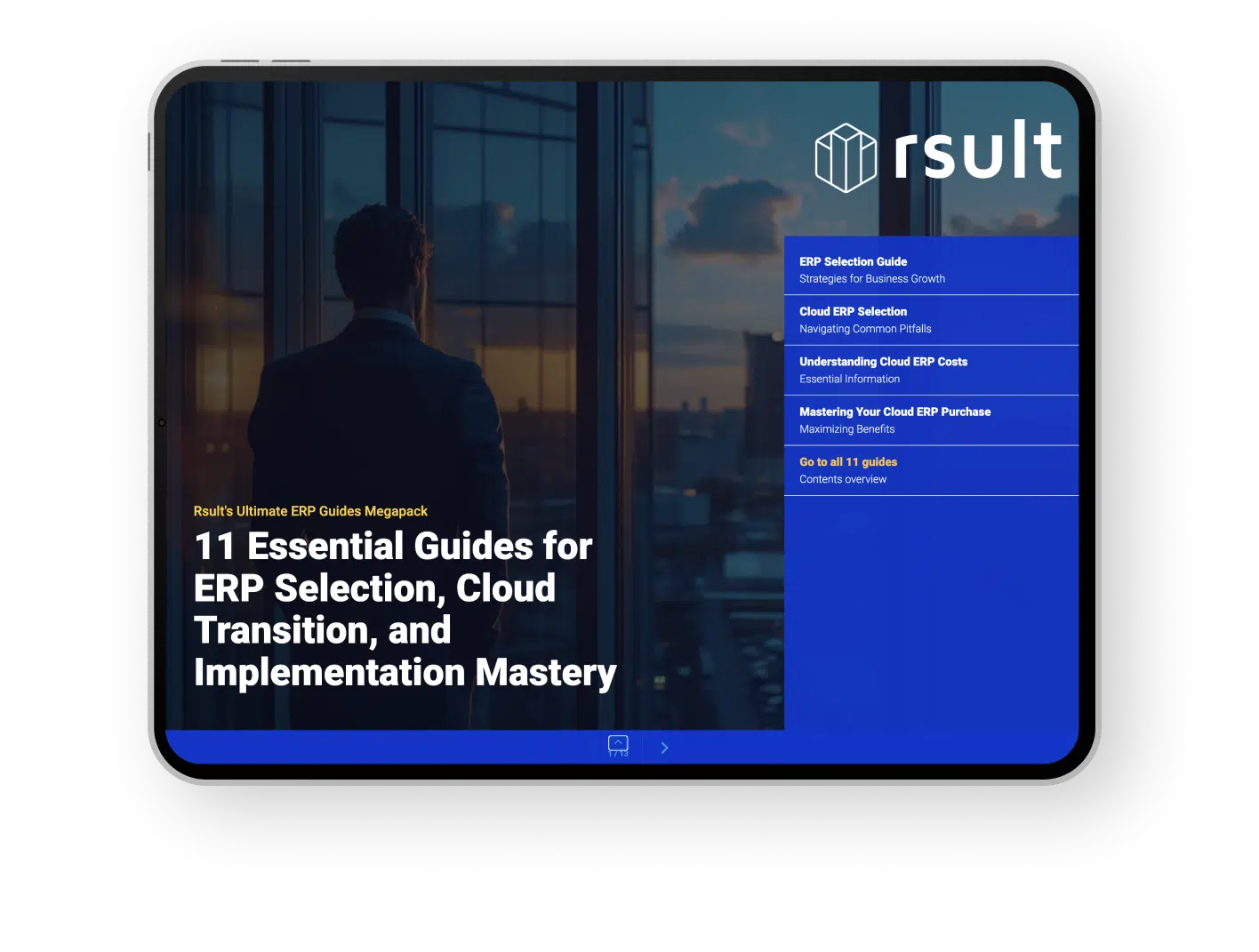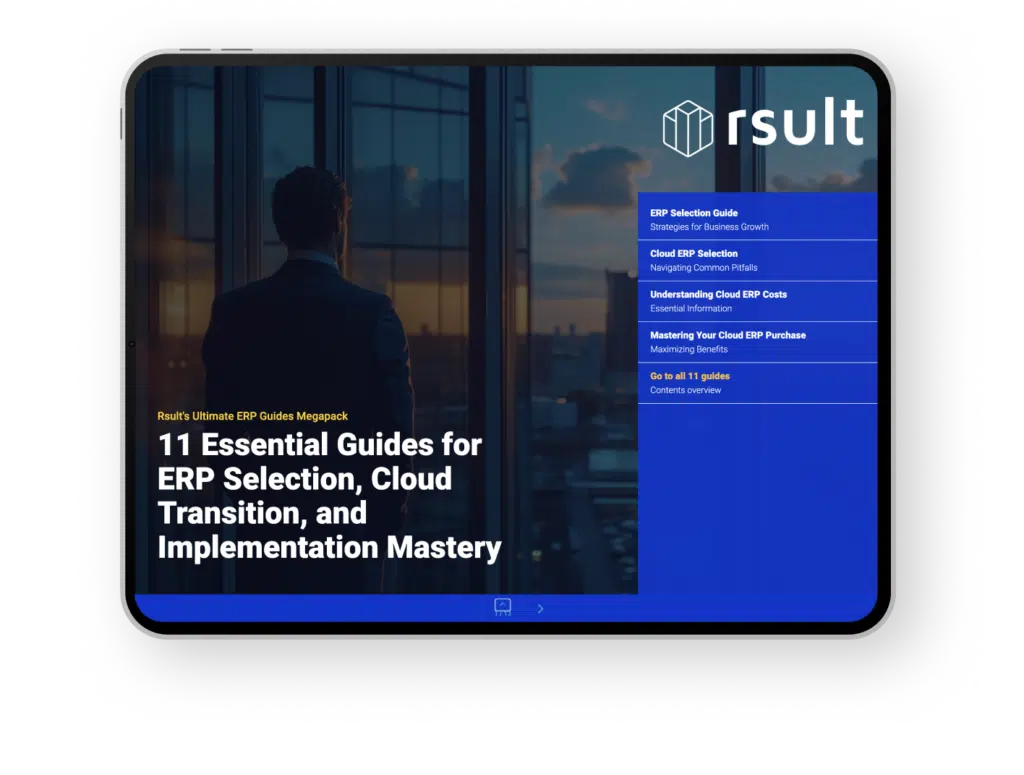When considering a significant addition to your business’s operational framework, the process of ERP evaluation is as critical as the solution itself. Navigating through the plethora of enterprise resource planning (ERP) options can seem daunting, but with a systematic approach to your enterprise resource planning assessment, you can identify a system that not only meshes with your current operations but also propels your business toward future success. Selecting an ERP system requires a fine balance of technological capability and practicality, ensuring all potential avenues for efficiency and growth are explored and addressed.
From improving productivity to supporting your expansion goals, the right ERP solution stands as a pivotal investment. It should encompass streamlined features that cater to your specific business model, all within the practical confines of your budget. The key to achieving this is to thoroughly understand your business needs and align them with the ERP system you choose.
Key Takeaways
- Selecting a compatible ERP system is crucial for business growth and efficiency.
- A detailed assessment aligns ERP capabilities with unique business requirements.
- Considering budget constraints ensures the sustainability of the ERP investment.
- Vendor support and system features are pivotal factors in the ERP evaluation process.
- Engagement in enterprise resource planning assessment aids in making an informed choice.
Understanding the Importance of ERP Evaluation
When it comes to refining business operations and technological infrastructure, the evaluation of an ERP (Enterprise Resource Planning) system becomes pivotal. Staying competitive in the modern business landscape requires a seamless and efficient approach to enterprise resource planning. By deeply examining ERP software evaluation criteria, companies can make informed decisions that align with their strategic objectives and support sustained growth.
What is ERP Evaluation?
An ERP evaluation is a comprehensive process used by companies to determine which ERP system best meets their unique requirements. It’s about evaluating ERP vendors, comparing system features, and aligning the software’s functionalities with a company’s operational needs and long-term plans. The rigor involved in this evaluation ensures that factors such as system fit, customizability, and vendor support are well-accounted for—minimizing risks and maximizing return on investment.
The Role of ERP Systems in Streamlining Business Operations
ERP systems serve as the technological backbone of a company, integrating various functions such as finance, HR, manufacturing, and supply chain management into a unified system. These powerful tools allow for an ERP system comparison not only in terms of capabilities but also how they harmonize disparate business processes, thereby facilitating a more streamlined and productive operational environment.
Aligning ERP Capabilities with Business Goals
For an ERP investment to truly pay off, its capabilities must resonate with a company’s business goals. This means that beyond evaluating ERP vendors for technical competence, one must ensure that the chosen system can scale and adapt to changing business dynamics. Such alignment is critical in fostering enhanced decision-making, leading to a resilient and future-proof business model.
Evaluating ERP software is not a trivial task; it requires intricate balancing of ERP software evaluation criteria, careful ERP system comparison, and keenness in evaluating ERP vendors. Each step in this process is aimed at not just meeting current needs, but also anticipating and facilitating future enterprise growth.
Identifying Your Business’s Unique Needs and Challenges
Commencing an ERP implementation evaluation requires a deep understanding of your business’s particular needs. The importance of ERP evaluation lies in its ability to uncover the unique challenges within your organizational processes. Grappling with manual data handling or fragmented systems? These are the types of issues that an ERP solution can address. However, identifying the scope of these problems is pivotal before even beginning to look for an ERP solution.
Consultation with internal stakeholders is fundamental. By drawing insights from various department heads, one can gain an intricate picture of the existing gaps in processes – from production to customer relations. This holistic view is instrumental in constructing a business case that methodically documents organizational needs, challenges, and aspirations. Think of this as the blueprint for your future ERP environment.
- Critical examination of data management and flow within the company
- Surveying the landscape of current operational inefficiencies
- Aligning ERP functions with long-term business strategies
- Understanding the scalability requirements for future growth
A successful ERP evaluation delves into the sectors of your business model. Does the finance department benefit more from an advanced analytics module? Will the inventory management team excel with better forecasting tools? Or perhaps, customer relationship management (CRM) is the linchpin to elevating client satisfaction and loyalty. Truly, the ERP implementation evaluation process is not just about the software – it’s about finding a partner for your organizational ambitions, matching capabilities to your market’s demands, and the importance of ERP evaluation unfolds as this becomes the catalyst for transformation.
The end goal? A tailored ERP system that not only smoothes out present wrinkles but also carries the potential to grow seamlessly with your company. Such precision in selecting ERP modules that directly counteract current inefficiencies paves the way for a dynamic, efficient future – one where business processes are no longer hurdles, but powerful levers for success.
Starting the ERP Evaluation Process
Embarking on an ERP evaluation can seem daunting, but following the best practices for ERP evaluation ensures a structured approach leading to the selection of an ERP system that aligns perfectly with your business goals. The journey starts with understanding your business requirements in depth and gathering the right team for the task.
Defining Business Requirements for the ERP System
Defining what your business needs from an ERP system is the cornerstone of the ERP evaluation framework. This step should involve an in-depth analysis of current business processes, pain points, and potential areas of improvement. It’s essential to consider not only immediate needs but also long-term goals that your chosen ERP system should support.
Assembling an ERP Selection Team
Choosing the right people for your ERP selection team is critical. This team should consist of individuals who understand the strategic objectives of your organization as well as the technical and functional requirements of the ERP system. It is recommended to include members from various departments to ensure all business needs are represented and addressed.
Creating Your Master ERP Requirement List
After defining the requirements and assembling your team, the next step is to consolidate this information into a master ERP requirement list. This document should articulate every nuance of your business process and how the ERP system can optimize these operations. A comprehensive list aids in systematically evaluating the potential of ERP systems to fulfill your business requirements.
| Requirement | Priority | Notes |
|---|---|---|
| Integration with current systems | High | Essential for streamlined operations across departments |
| Scalability for future growth | Medium | Must not restrict expansion to new markets or product lines |
| Customizability | Medium | Ability to tailor system to specific workflows |
| User-friendliness | High | Ensures higher adoption rates among staff |
| Vendor support & training | High | Critical for the smooth implementation and ongoing maintenance |
In keeping with the best practices for ERP evaluation, the requirements listed should be vetted against each potential ERP system, ensuring compatibility and suitability for your business’s unique dynamics. A thorough ERP evaluation process, defined by a robust ERP evaluation framework, underpins the success of the system’s implementation and its ability to enhance business performance.
Selecting the Right ERP Evaluation Framework
Choosing an effective ERP evaluation framework is critical when aiming to perform an ERP system comparison. This systematic approach helps prioritize your business needs, ensuring that the selecting ERP system process is aligned with your organizational goals. A robust framework takes into consideration a myriad of factors that influence the success of an ERP implementation.
- System Functionality: How well does the ERP system perform the tasks it needs to?
- User Experience: Is the system user-friendly and does it enhance productivity?
- Ease of Implementation: Can the ERP be integrated smoothly without major disruptions?
- Scalability: Will the system grow with your business?
- Vendor Reputation: Is the provider recognized for quality service and support?
To aid decision-makers in the process of selecting ERP systems, a comparative table can illustrate the key aspects of potential ERP solutions, comparing them side by side.
| Criteria | ERP System A | ERP System B | ERP System C |
|---|---|---|---|
| Functionality | Comprehensive, with advanced analytics | Basic functions with additional modules | Customizable to a range of business needs |
| User Experience | Intuitive and mobile-friendly | Requires minimal training | Highly customizable user interface |
| Implementation Ease | Quick setup with pre-configured templates | Moderate customization required | Extended setup due to complex features |
| Scalability | Built for small to medium businesses | Scalable with pay-as-you-grow model | Designed for large enterprises |
| Vendor Reputation | Highly reputable with strong customer support | Emerging with growing recognition | Well-established with global outreach |
Engaging in high-level questioning with ERP vendors about system fit, budget, and capabilities can substantially refine your list of potentials. ERP system comparison is not a task to rush; by weighing the pros and cons detailed in your chosen framework, you can make an informed decision ensuring that the system you select will bolster your operational efficiency and contribute positively to your long-term business aspirations.
Assessing ERP Software Evaluation Criteria
Embarking on an ERP implementation evaluation requires an in-depth look at various essential factors to ensure that the final choice aligns with a company’s goals and workflow. The ERP evaluation framework includes scrutinizing ERP evaluation criteria to guarantee that integration, cost, and technological growth capacity are not overlooked.
Evaluating System Integration and Compatibility
When evaluating ERP systems, it’s crucial to consider how well a new system will integrate with existing software and processes. Seamless integration ensures smooth operations and data consistency, vital for the success of ERP implementation evaluation.
Examining Vendor Technology and Scalability
Understanding the scalability and technology offered by an ERP vendor can inform how well the system will adapt to future business changes and growth. This is a key component of the ERP evaluation criteria, influencing the long-term viability of the investment.
Understanding Total Cost of Ownership and ROI
An in-depth ERP evaluation framework must take into account not just the initial cost but the total cost of ownership (TCO) and the potential return on investment (ROI). Factoring in these financial implications ensures an ERP choice that provides long-term value over time.
| ERP Evaluation Criteria | Checklist | Notes |
|---|---|---|
| System Compatibility |
|
Ensure the ERP integrates seamlessly with existing tools and systems, minimizing disruptions. |
| Vendor Technology |
|
Assess if the ERP system’s technology aligns with current and future business needs. |
| Scalability |
|
Ensure the system can grow with your business, adding functionality as needed. |
| Total Cost of Ownership |
|
Consider all costs associated with the ERP system to understand its true financial impact. |
Comparing ERP Systems to Find the Best Fit
Choosing the right enterprise resource planning system requires an in-depth enterprise resource planning assessment to ensure business alignment and long-term value. When evaluating ERP vendors, businesses must conduct thorough comparisons encompassing diverse features and capabilities. A meticulous assessment can determine if an ERP system not only meets the current requirements but is also equipped for future business expansions and technological advancements. The objective goes beyond mere feature comparison—it’s about discerning which ERP solution seamlessly integrates with your business workflows, supports your growth trajectory, and delivers a sustainable competitive edge.
An effective comparison involves taking a close look at vendors based on critical factors like scalability, integration potential, and the overall investment impact. While evaluating, businesses should consider:
- The system’s ease of use and how well it can be adopted by the workforce.
- The level of system integration possible with existing workflows and technology stacks.
- The vendor’s ability to deliver future-proof technological solutions.
- The reputation of the ERP vendor, assessed through case studies, customer testimonials, and industry recognition.
These qualitative assessments are as crucial as quantitative ones. Financial considerations play a paramount role in evaluating ERP vendors. Estimating the total cost of ownership involves analyzing not only the upfront costs but also the ongoing operational expenses against the forecasted ROI. As part of the enterprise resource planning assessment, determining a budget based on the company’s financial well-being and growth prospects is essential for a decision that supports the business’s trajectory without overstraining its resources.
- Cost of implementation and customization.
- Training and support expenses.
- Upgrade and maintenance costs.
Inadequate or superficial comparisons are a common pitfall that can result in selecting an ERP system that fails to address specific business challenges. Only through a deliberate and detailed comparison process can an organization find an ERP solution that embodies a truly perfect fit for its unique needs.
Gathering Stakeholder Input During the Evaluation
To uphold the best practices for ERP evaluation, it’s essential to embrace a holistic approach that values the perspectives and insights of various stakeholders. Shaping a successful ERP evaluation depends on the diversity and depth of stakeholder participation throughout the process. This section unfolds the significance of stakeholder input and lays out key strategies for their engagement and feedback integration.
Engaging End-users and Department Heads
Inviting end-users and department heads to contribute to the ERP discussion offers a reservoir of wisdom crucial in delineating a system that truly complements organizational workflows. It’s not merely about adopting technology; it’s anchoring it in the reality of day-to-day operations across departments such as sales, procurement, finance, and HR. Successful ERP evaluation taps into these experiential insights to highlight requisites and refinements needed in an ERP system.
Fostering Collaborative Decision Making
The journey towards a successful ERP evaluation is paved by collaborative decision-making. The fabric of any enterprise reflects a spectrum of perspectives, each with the potential to hone the ERP choice to what’s most beneficial for the entity. This collaborative spirit energizes a company-wide endorsement, ensuring the ERP solution isn’t merely introduced but wholeheartedly integrated.
Incorporating Feedback into the Selection Process
A cogent ERP selection process is responsive to the collective feedback of those it is intended to serve. The confluence of suggestions, concerns, and validations from stakeholders establishes a foundation for a finely tuned ERP evaluation. This inclusionary practice not only cements a sense of ownership among contributors but aligns potential ERP acquisitions with actual enterprise requirements.
| Stakeholder Group | Key Role in ERP Evaluation | Examples of Valuable Insights |
|---|---|---|
| End-users | Provide user-experience input | Usability challenges, desired features |
| Department Heads | Clarify department-specific needs | Specialized functionality, integration requirements |
| IT Department | Advise on technical compatibility | System infrastructure, data migration strategies |
| Finance | Offer budgetary guidance | Cost considerations, ROI expectations |
| HR | Illuminate on workforce implications | Training needs, user adoption tactics |
Ensuring Successful ERP Implementation and Vendor Support
Achieving a successful ERP implementation evaluation and robust ERP vendor support involves a critical mix of thorough planning and meticulous selection. Key factors such as management support, transparent communication, user training, and a firm focus on the business’s operational needs are the cornerstones of a smooth ERP rollout. To effectively navigate through the challenges that might arise during the course of ERP implementation, businesses need to prioritize vendor support from the outset, ensuring that any issues can be swiftly addressed, and adjustments can be made to suit evolving business requirements.
ERP vendor support plays a crucial role in the post-implementation phase. A strong partnership with the vendor can significantly enhance the long-term value of the ERP system. When it becomes necessary to adapt to new business processes or troubleshoot technical issues, having a responsive and knowledgeable ERP vendor is essential. Continuous vendor support not only helps in resolving these challenges but also in tapping into the full potential of the ERP system, maximizing its benefits for the business.
The table below provides an overview of the critical elements to consider when evaluating ERP vendor support during the ERP implementation process, ensuring that businesses select a vendor capable of providing comprehensive support throughout the lifecycle of the system.
| Consideration | Details | Outcome |
|---|---|---|
| Project Management | Effective coordination and communication channels established between the business and the vendor’s project management team. | Alignment of project goals, smooth execution, and timely completion. |
| Technical Support | Availability of expert technical support for troubleshooting and optimizations post-implementation. | Reduced system downtime and continuous operational efficiency. |
| Training and Resources | Provision of comprehensive user training and resources for the ERP system. | Enhanced user adoption, less resistance, and improved productivity. |
| Customization and Updates | Capability to handle system customizations and provide regular updates in line with evolving business needs. | A flexible and scalable ERP system that grows with the business. |
| Strategic Advising | Access to industry insights and strategic advising to harness the full potential of the ERP solution. | Better decision-making capabilities and competitive advantage. |
It is imperative that businesses collaborate closely with selected ERP vendors, establishing a relationship built on trust and mutual understanding. Vendors should not only be assessed based on their software but also on the support infrastructure they provide, ensuring any potential risks are managed and beneficial outcomes are attained for everyone involved.
- Continuous Improvement: ERP implementation is not a one-time event but a continuous journey toward business process optimization.
- Critical Evaluation: Regular ERP implementation evaluation helps identify areas for improvement and ensures the software continues to meet business needs.
- Active Management: Engaged vendor support is fundamental for a dynamic response to changing business environments and demands.
In conclusion, the importance of ERP vendor support post-implementation cannot be overstated. It’s the safeguard against operational disruptions and a gateway to evolving the system in line with technological advancements and business growth aspirations.
Conclusion
The culmination of a thorough ERP evaluation is a testament to a business’s commitment towards enhancing its operational efficiency and decision-making prowess. By diligently evaluating ERP solutions, companies lay the groundwork for ERP project success, aiming to build a strategic edifice that supports continuous growth and productivity. An effective ERP strategy does not merely involve choosing the most advanced technology; it is about finding a solution that speaks directly to the unique contours of business requirements.
In every phase, from assessing software criteria to involving stakeholders, the central theme is clear: understanding business needs is paramount. A system that aligns perfectly with a company’s existing and future processes ensures a seamless integration that can streamline workflows and fortify the organization’s technological backbone. Incorporating feedback across departments fosters a collective confidence in the chosen system and encourages organization-wide investment in the project’s success.
Ultimately, the true measure of success in any ERP initiative is reflected in the return on investment and enhanced day-to-day operations it yields. An ERP system, selected with precision and forward-thinking, becomes more than just a tool—it evolves into a cornerstone of the business’s evolving narrative. With a methodical approach to evaluating ERP solutions, businesses can secure a technological ally poised to support their ascent towards operational excellence and strategic triumph.






